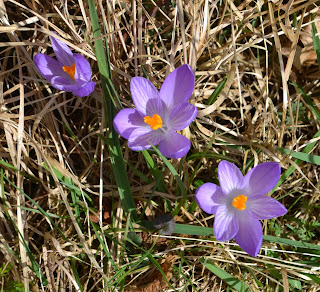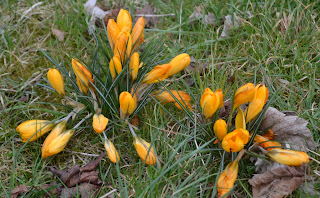Length: 20 minutes
& 30 minutes, with a drive in between.
We parked by the Village Hall at SU372642. Immediately south of here is
Galanthus
nivalis 'flore
pleno'
A track peels off left to the Crocus Field after about the fifth house. Under the hedge were two other garden escapes, the spotted leaves of Lungwort Pulmonaria officinalis, and Creeping Comfrey Symphytum grandiflorum, but the latter had been badly affected by the current cold snap after a "false spring" a few days before had encouraged it to come out in full flower. (Today the air temperature was 1ºC, with a very cold east wind that gave a chill factor of some -6 or -7ºC.)
Creeping comfrey devastated
by frost
At the end of this short lane a gate leads into the Crocus Field, a pasture bordered by gardens on the north and east sides and sloping SW down to a brook, where it rises again beyond.
The Crocus Field from
across the brook
The dark purple Spring Crocuses Crocus vernus - there seemed to be just the one species - are distributed all over the first field, with a few having established themselves in the grass beyond the stream, where there were also some small clumps of Primrose Primula vulgaris in flower under scrub.
Primrose
Spring crocus in Crocus
Field
Sheltered crocuses open in
the sun
A few white crocuses can be
found among the purple
The young ferny shoots of Pignut Conpodium majus were conspicuous in the turf, confirming that this has long been unfertilised pasture.
Spring crocus and pignut
leaves, Crocus Field
The stream flowed under a thin coating of ice that had made pleasant patterns. This was the first time we had got round to visiting this unique site and we found it well worthwhile.
Icy brook
The Causeway, Steventon,
near the church
The marsh is now
dry and occupied by allotments, parkland and a playground. The grassy sides of the embankment are
planted to a mixture of common bulb-plants.
Those currently in flower (there were many daffodils yet to come) included
more snowdrops as above, as well as the simple flowered version, also Winter
Aconite, the pale purple Early Crocus Crocus
tommasinianus, Compact Grape-Hyacinth Muscari
botryoides, Daffodils Narcissus
pseudonarcissus ssp pseudonarcissus, 'Bob Minor' (similar to last but
deeper yellow petals), 'February Gold' and the neat dwarf cultivar
'Tête-à-Tête', yellow Dutch Crocus Crocus x luteus and more spring crocus,
but a deeper shade than at Inkpen.
Planted spring crocus by
the Causeway are darker than those at Inkpen
Compact grape-hyacinth
(which has hooded leaf-tips)
Daffodils 'Bob Minor' and
'Tete a tete'
Daffodil 'February Gold'
Dutch crocus
The stream bordering the causeway, which presumably drains the lower land (although the water-table is no doubt lower now anyway), supports Lesser Celandine Ficaria verna and primrose.
Stream near The Causeway
with snowdrops
Lumpy bracket
Arch-supported barn near
Manor House, Steventon
The church dates back to before 1086, and there must have been an earlier church on the site, as there is a venerable 1200-year-old Yew Taxus baccata at its SW corner, massive in girth, although not all that extensive in height and reach, which may have survived from an even earlier Celtic religious foundation.
Old yew Steventon Church
Bole of old plane-tree by
wall of Steventon
Church
The grass is
well-mown and contains few species of interest.
There is a patch of snowdrops and a small fenced area just to the right
of the entrance with winter aconite, Dutch and early crocus, snowdrops, and
daffodils 'Tête-à-Tête', just past which, by the path, is a clump of Stinking
Iris or Gladdon Iris foetidissima, so
common by old churches for some reason.
Steventon churchyard: early
crocus, Tete a Tete daffodil, snowdrop, winter aconite





















No comments:
Post a Comment